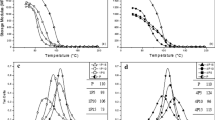Abstract
Thermally induced healing through thermoplastic poly(ε-caprolactone) (PCL), dissolved in 12.5, 25, 37.5 and 50 wt%, respectively, in amine-cured epoxy resins (EPs) was studied on compact tension (CT) specimens. Aromatic (hydrogenated diglycidyl ether of bisphenol A-type) and aliphatic (glycerol-triglycidylether) EPs were cured with the same amine (Jeffamine D 230) to receive EPs with different glass transition temperatures (T g). T g values of the parent EPs were lower (T g = 32 °C) and higher (T g = 90 °C), respectively, than the melt temperature (T m ≈ 60 °C) of the PCL. The curing-induced phase separation morphology of PCL was studied by light microcopy. Additional information on the phase structure was deduced from dynamic mechanical analysis. Blending with PCL reduced the T g of the corresponding EPs. Fully broken CT specimens were repeatedly healed at 80 °C which was close to or higher than the actual T g of the EP/PCL blend. It was found that the transition of PCL from disperse to continuous phase depends not only on the PCL amount, but also on the EP type and its curing. EP/PCL systems with semi-interpenetrating network structure (bi-continuous) exhibited markedly higher healing efficiencies compared to those in which PCL was present as disperse phase. The healing efficiency depended also on the temperature difference between the healing temperature and T g of the EP with respect to T m of PCL. When T g > T m then the related difference should be kept small, while for T g < T m the temperature difference should be large to support healing. Accordingly, the segmental mobility within the cross-linked EP network is a key parameter for thermal mending, too.







Similar content being viewed by others
References
Blaiszik B, Kramer S, Olugebefola S, Moore J, Sottos N, White S (2010) Self-healing polymers and composites. Annu Rev Mater Res 40:179–211
Karger-Kocsis J, Mahmood H, Pegoretti A (2015) Recent advances in fiber/matrix interphase engineering for polymer composites. Prog Mater Sci 73:1–43
Jud K, Kausch HH (1979) Load transfer through chain molecules after interpenetration at interfaces. Polym Bull 1:697–707
Jud K, Kausch HH, Williams JG (1981) Fracture mechanics studies of crack healing and welding of polymers. J Mater Sci 16:204–210
Tsangouri E, Aggelis D, van Hemlrijck D (2015) Quantifying thermoset polymers healing efficiency: a systematic review of mechanical testing. Prog Polym Sci 49–50:154–174
Pascault J-P, Williams RJJ (eds) (2010) Epoxy polymers. Wiley-VCH, Weinheim
Karger-Kocsis J, Kéki S (2014) Shape memory biodegradable polyesters: concepts of (supra)molecular architecturing. Express Polym Lett 8:397–412
Siddhamalli SK (2000) Toughening of epoxy/polycaprolactone composites via reaction induced phase separation. Polym Compos 21:846–855
Rotrekl J, Matějka L, Kaprálková L, Zhigunov A, Hromádková J, Kelnar I (2012) Epoxy/PCL nanocomposites: effect of layered silicate on structure and behavior. Express Polym Lett 6:975–986
Luo X, Ou R, Eberly DE, Singhal A, Viratyaporn W, Mather PT (2009) A thermoplastic/thermoset blend exhibiting thermal mending and reversible adhesion. ACS Appl Mater Interface 1:612–620
Fejős M, Molnár K, Karger-Kocsis J (2013) Epoxy/polycaprolactone systems with triple-shape memory effect: electrospun nanoweb with and without graphene versus co-continuous morphology. Materials 6:4489–4504
Yuan YC, Yin T, Rong MZ, Zhang MQ (2008) Self healing in polymers and polymer composites. Concepts, realization and outlook: a review. Express Polym Lett 2:238–250
Wei H, Yao Y, Liu Y, Leng J (2015) A dual-functional polymeric system combining shape memory with self-healing properties. Compos B 83:7–13
Yao Y, Wang J, Lu H, Xu B, Fu Y, Liu Y, Leng J (2016) Thermosetting epoxy resin/thermoplastic system with combined shape memory and self-healing properties. Smart Mater Struct 25:015021
Tuba F, Khumalo VM, Karger-Kocsis J (2013) Essential work of fracture of poly(ε-caprolactone)/boehmite alumina nanocomposites: effect of surface coating. J Appl Polym Sci 129:2950–2958
Varley RJ, Dao B, Pillsbury Ch, Kalista SJ, Jones FR (2014) Low-molecular-weight thermoplastic modifiers as effective healing agents in mendable epoxy networks. J Intell Mater Syst Struct 25:107–117
Jones AR, Watkins CA, White SR, Sottos NR (2015) Self-healing thermoplastic-toughened epoxy. Polymer 74:254–261
Acknowledgments
The contribution of Mr. K. Lovász and Mrs. M. Fejős to this work is greatly appreciated. PCL (Capa 6400) was kindly provided by Perstorp UK Ltd. This work was partly also supported by OTKA SNN 114547.
Author information
Authors and Affiliations
Corresponding author
Rights and permissions
About this article
Cite this article
Karger-Kocsis, J. Self-healing properties of epoxy resins with poly(ε-caprolactone) healing agent. Polym. Bull. 73, 3081–3093 (2016). https://doi.org/10.1007/s00289-016-1642-2
Received:
Revised:
Accepted:
Published:
Issue Date:
DOI: https://doi.org/10.1007/s00289-016-1642-2




